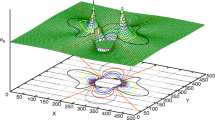Abstract
Constitutive models of particulate materials often rely on distances between the current stress state in stress space and various surfaces. Examples of these surfaces include the bounding surface and the dilatancy surface. This paper proposes a rigorous method for determination of distance to a surface in stress space. It starts by examining operations on stress variables defined in the \(\pi \) plane. Algorithms for determination of an image point on a surface are then presented as a function of the location of the current stress state with respect to the surface. For points within the surface, the bisection method is used; otherwise, the secant method is used. The paper shows that implementation of the proposed algorithm locates the image point on a surface in stress space with accuracy and rigor, providing an accurate measure of the distance to the surface that can be used in hardening or flow rules.















Similar content being viewed by others
References
Andrianopoulos KI, Papadimitriou AG, Bouckovalas GD (2010) Explicit integration of bounding surface model for the analysis of earthquake soil liquefaction. Int J Numer Anal Methods Geomech 34:1586–1614. doi:10.1002/Nag.875
Chakraborty T, Salgado R, Loukidis D (2013) A two-surface plasticity model for clay. Comput Geotech 49:170–190. doi:10.1016/j.compgeo.2012.10.011
Dafalias YF, Papadimitriou AG, Li XS (2004) Sand plasticity model accounting for inherent fabric anisotropy. J Eng Mech 130:1319
Dafalias YF, Popov EP (1975) A model of nonlinearly hardening materials for complex loading. Acta Mech 21:173–192. doi:10.1007/BF01181053
El-tawil S, Deierlein GG (2001) Nonlinear analysis of mixed steel-concrete frames. I: element formulation. J Struct Eng 127:647–655
Loukidis D, Salgado R (2009) Modeling sand response using two-surface plasticity. Comput Geotech 36:166–186, 2008. doi:10.1016/J.Compgeo.02.009
Lubliner J (1990) Plasticity theory. Macmillan, New York
Manzari MT, Dafalias YF (1997) A critical state two-surface plasticity model for sands. Géotechnique 47:255–272
Sheng D, Augarde CE, Abbo AJ (2011) A fast algorithm for finding the first intersection with a non-convex yield surface. Comput Geotech 38:465–471. doi:10.1016/j.compgeo.2011.02.008
Taiebat M, Dafalias YF (2008) SANISAND: simple anisotropic sand plasticity model. Int J Numer Anal Methods Geomech 32:915–948. doi:10.1002/Nag.651
Yang B-L, Dafalias YF, Herrmann LR (1985) A bounding surface plasticity model for concrete. J Eng Mech 111:359–380
Author information
Authors and Affiliations
Corresponding author
Rights and permissions
About this article
Cite this article
Woo, S.I., Salgado, R. Determination of an image point on a surface based on a \(\pi \) plane-based algorithm. Comput Mech 53, 1033–1046 (2014). https://doi.org/10.1007/s00466-013-0947-3
Received:
Accepted:
Published:
Issue Date:
DOI: https://doi.org/10.1007/s00466-013-0947-3




